Auriel's Trial Balance: Source, Structure, and Year-End Adjustments
VerifiedAdded on 2024/06/03
|6
|767
|196
Report
AI Summary
This report provides a detailed analysis of Auriel's trial balance, assessing its source and structure, which originates from ledger balances after journal entries, ensuring debits and credits are balanced as per double-entry accounting principles. It evaluates the impact of year-end adjustments, including accrual expenses (unpaid expenses like salaries), prepaid expenses (advance payments like insurance), depreciation (wear and tear on fixed assets), and provision for doubtful debts (estimated bad debts), on the business's income statement and balance sheet, explaining how these adjustments affect the presentation of financial information and the overall financial position of the company. The report references key accounting texts to support its analysis and conclusions.
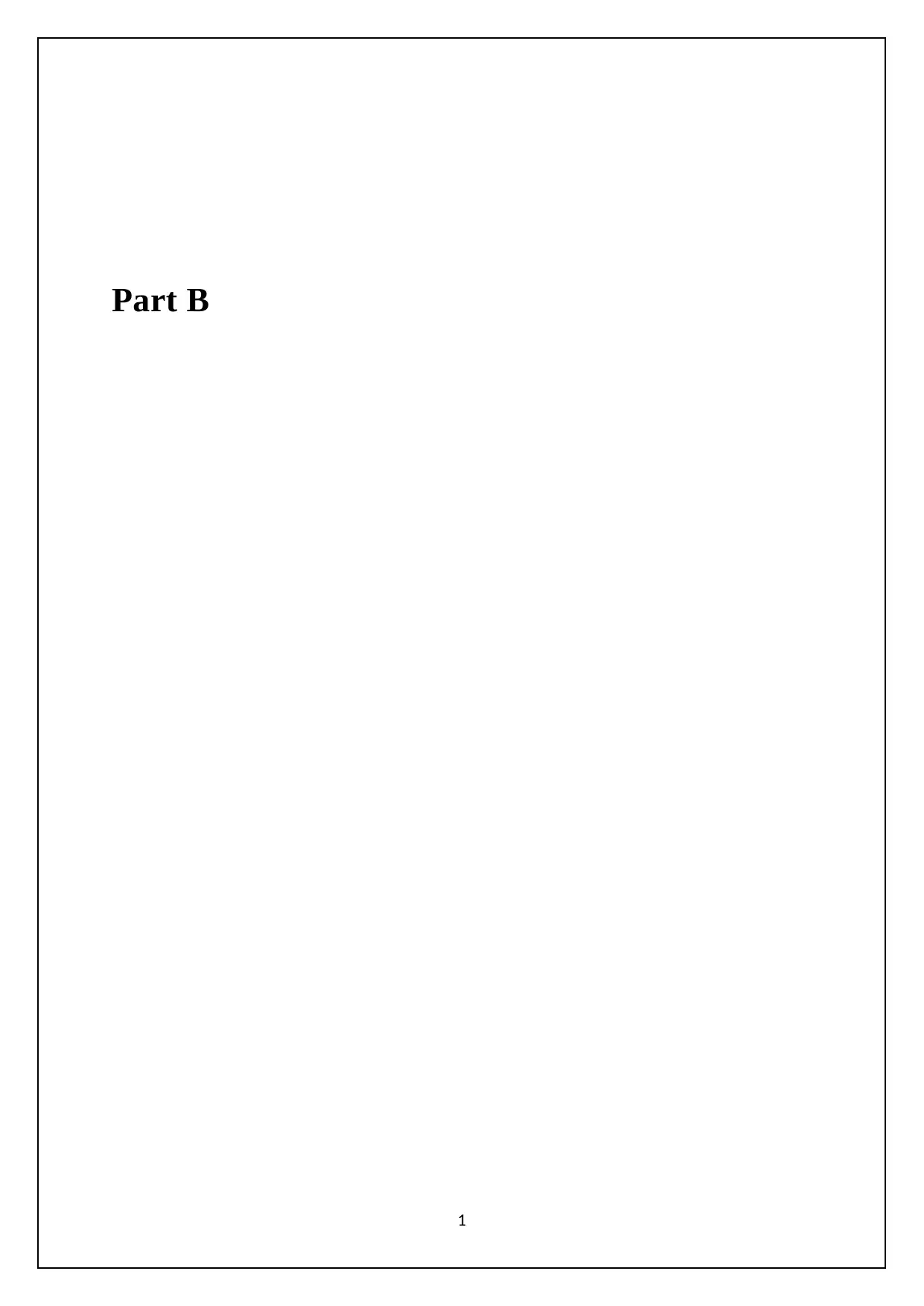
Part B
1
1
Paraphrase This Document
Need a fresh take? Get an instant paraphrase of this document with our AI Paraphraser
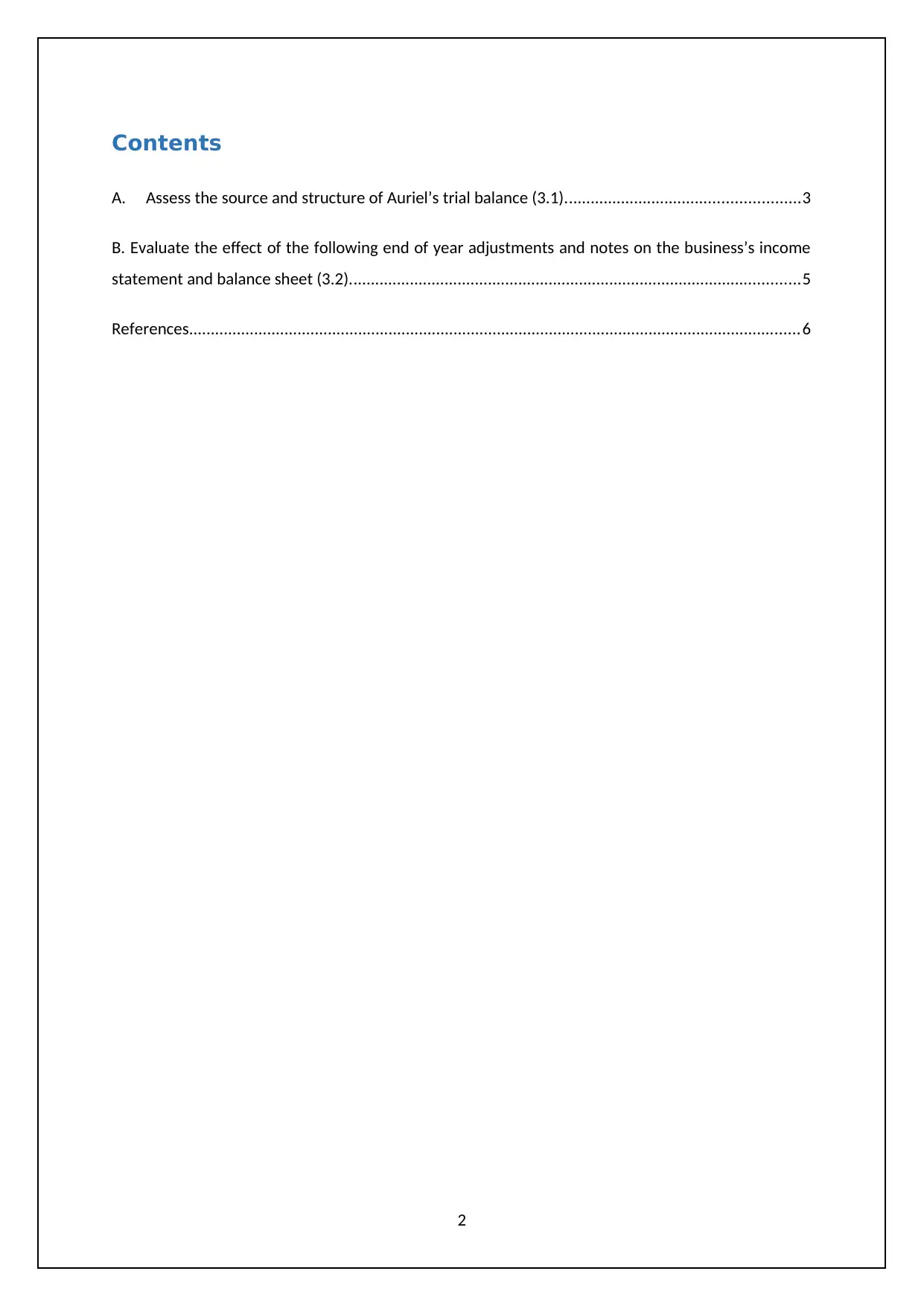
Contents
A. Assess the source and structure of Auriel’s trial balance (3.1)......................................................3
B. Evaluate the effect of the following end of year adjustments and notes on the business’s income
statement and balance sheet (3.2)........................................................................................................5
References.............................................................................................................................................6
2
A. Assess the source and structure of Auriel’s trial balance (3.1)......................................................3
B. Evaluate the effect of the following end of year adjustments and notes on the business’s income
statement and balance sheet (3.2)........................................................................................................5
References.............................................................................................................................................6
2
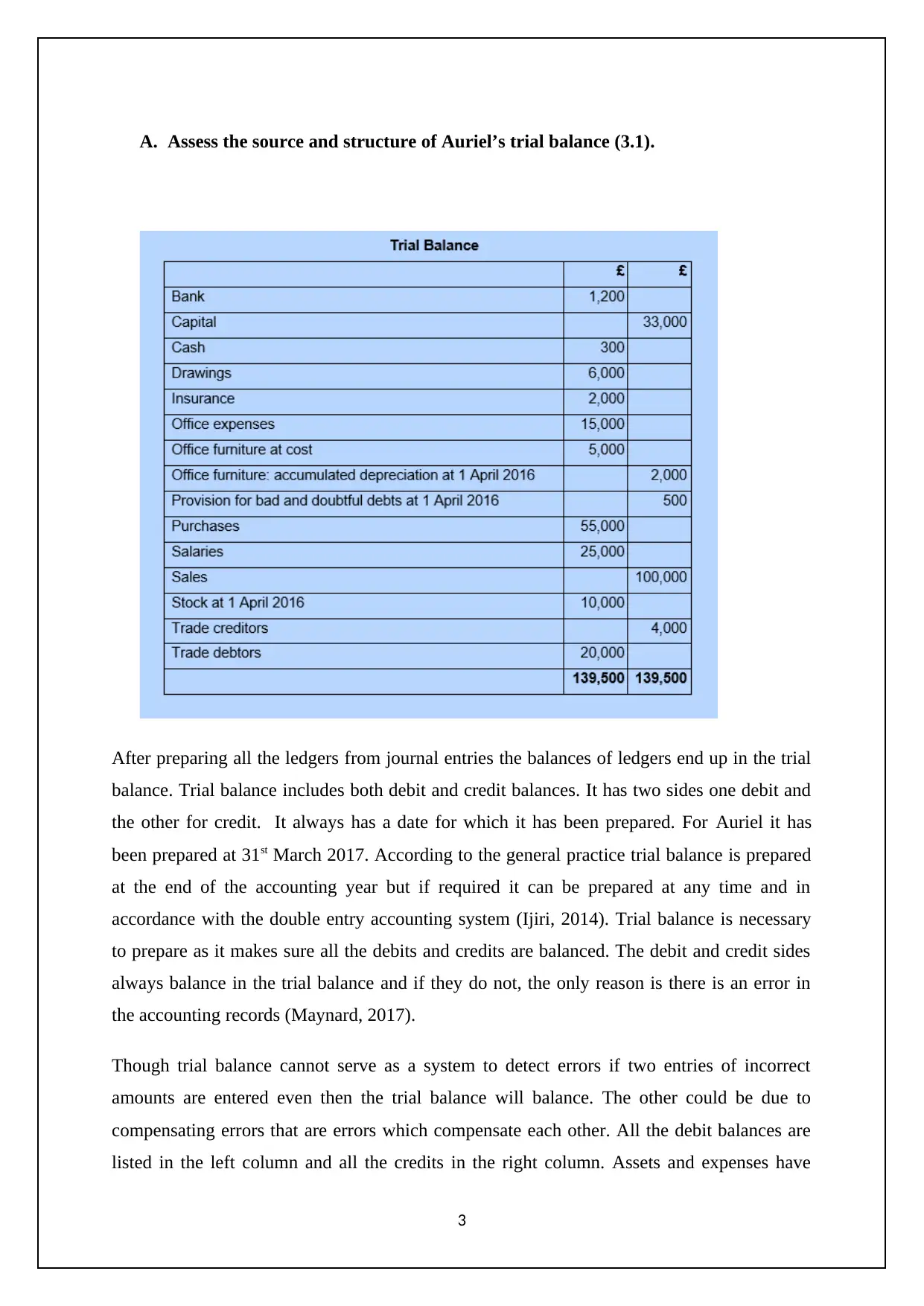
A. Assess the source and structure of Auriel’s trial balance (3.1).
After preparing all the ledgers from journal entries the balances of ledgers end up in the trial
balance. Trial balance includes both debit and credit balances. It has two sides one debit and
the other for credit. It always has a date for which it has been prepared. For Auriel it has
been prepared at 31st March 2017. According to the general practice trial balance is prepared
at the end of the accounting year but if required it can be prepared at any time and in
accordance with the double entry accounting system (Ijiri, 2014). Trial balance is necessary
to prepare as it makes sure all the debits and credits are balanced. The debit and credit sides
always balance in the trial balance and if they do not, the only reason is there is an error in
the accounting records (Maynard, 2017).
Though trial balance cannot serve as a system to detect errors if two entries of incorrect
amounts are entered even then the trial balance will balance. The other could be due to
compensating errors that are errors which compensate each other. All the debit balances are
listed in the left column and all the credits in the right column. Assets and expenses have
3
After preparing all the ledgers from journal entries the balances of ledgers end up in the trial
balance. Trial balance includes both debit and credit balances. It has two sides one debit and
the other for credit. It always has a date for which it has been prepared. For Auriel it has
been prepared at 31st March 2017. According to the general practice trial balance is prepared
at the end of the accounting year but if required it can be prepared at any time and in
accordance with the double entry accounting system (Ijiri, 2014). Trial balance is necessary
to prepare as it makes sure all the debits and credits are balanced. The debit and credit sides
always balance in the trial balance and if they do not, the only reason is there is an error in
the accounting records (Maynard, 2017).
Though trial balance cannot serve as a system to detect errors if two entries of incorrect
amounts are entered even then the trial balance will balance. The other could be due to
compensating errors that are errors which compensate each other. All the debit balances are
listed in the left column and all the credits in the right column. Assets and expenses have
3
⊘ This is a preview!⊘
Do you want full access?
Subscribe today to unlock all pages.

Trusted by 1+ million students worldwide
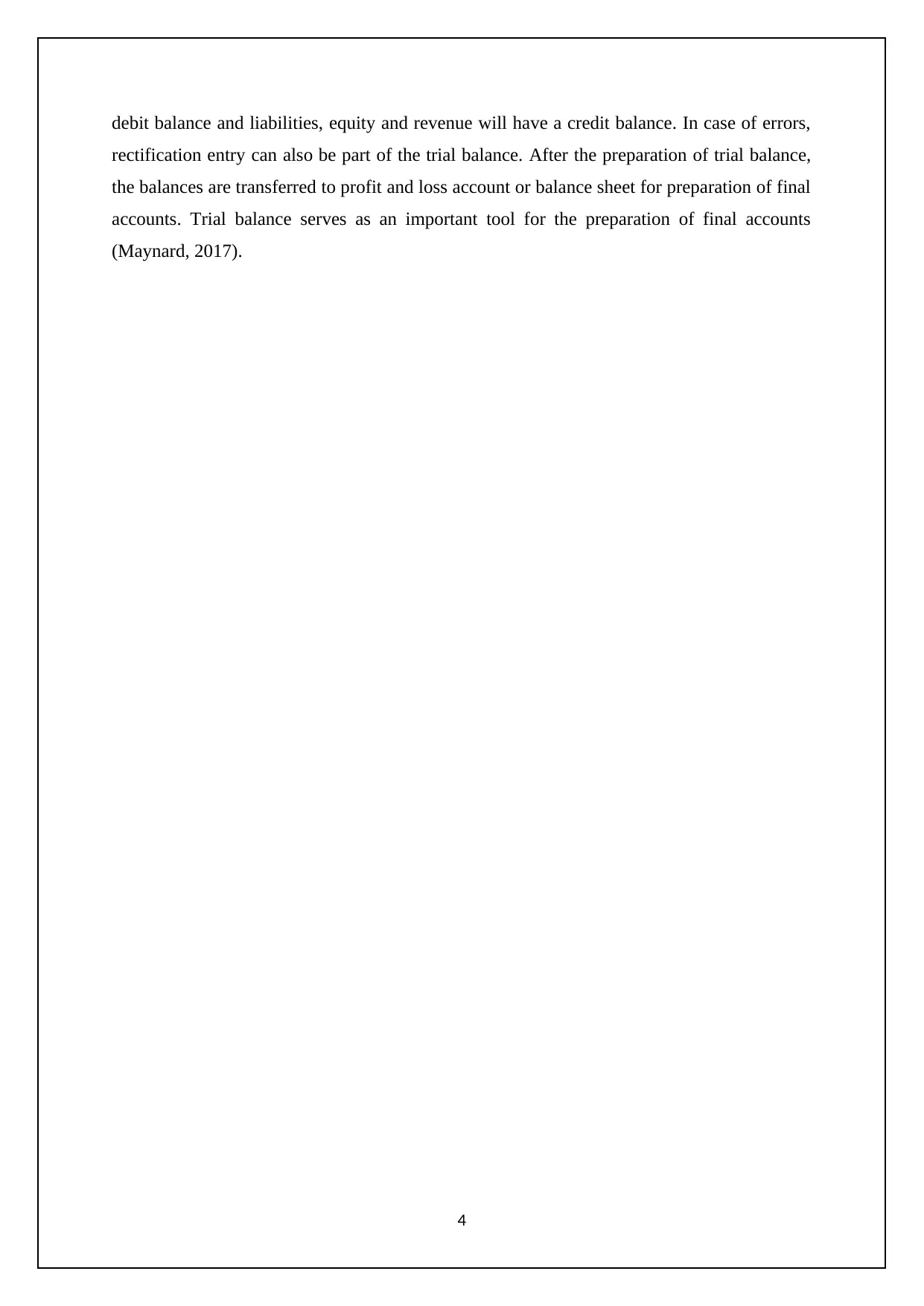
debit balance and liabilities, equity and revenue will have a credit balance. In case of errors,
rectification entry can also be part of the trial balance. After the preparation of trial balance,
the balances are transferred to profit and loss account or balance sheet for preparation of final
accounts. Trial balance serves as an important tool for the preparation of final accounts
(Maynard, 2017).
4
rectification entry can also be part of the trial balance. After the preparation of trial balance,
the balances are transferred to profit and loss account or balance sheet for preparation of final
accounts. Trial balance serves as an important tool for the preparation of final accounts
(Maynard, 2017).
4
Paraphrase This Document
Need a fresh take? Get an instant paraphrase of this document with our AI Paraphraser
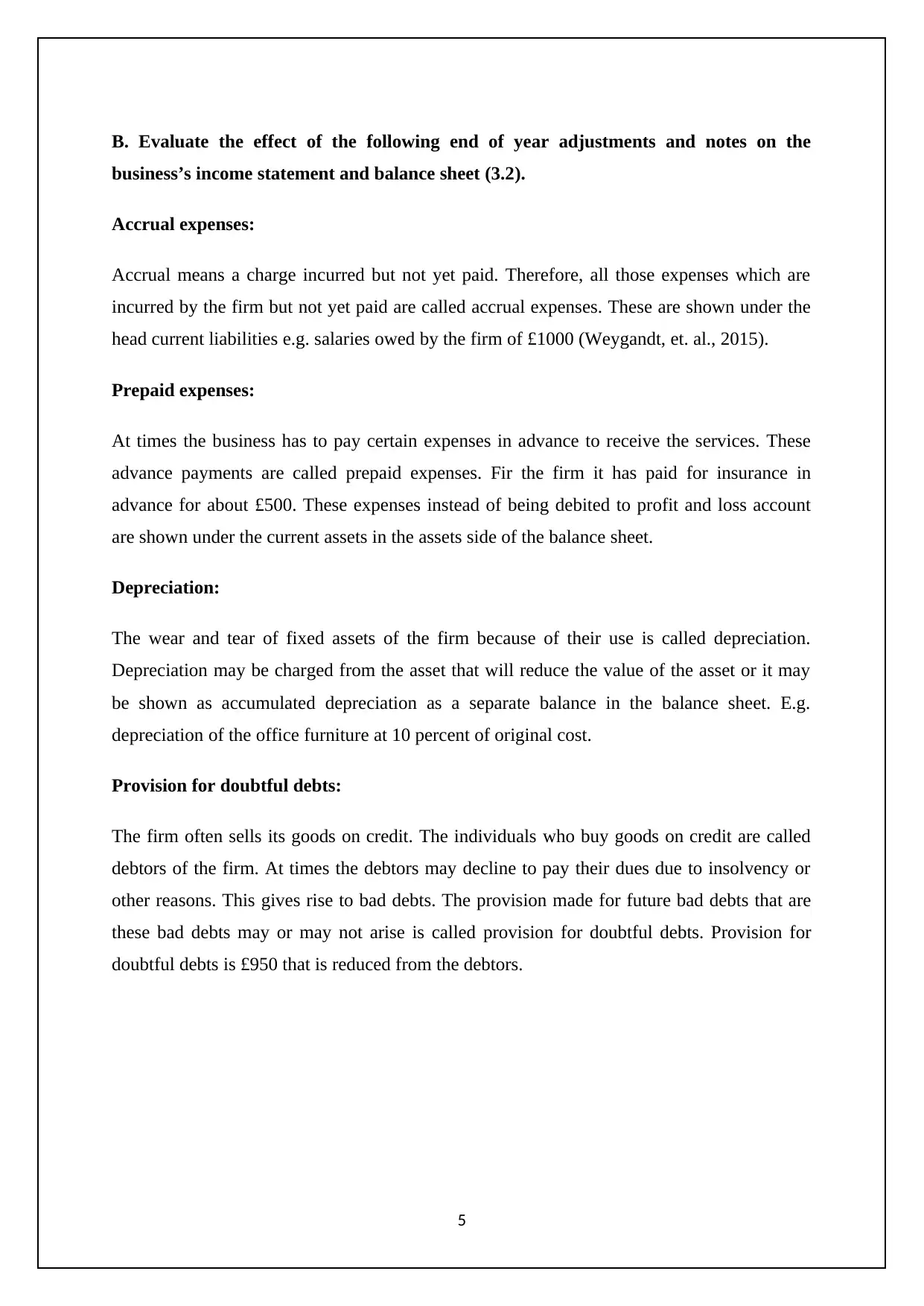
B. Evaluate the effect of the following end of year adjustments and notes on the
business’s income statement and balance sheet (3.2).
Accrual expenses:
Accrual means a charge incurred but not yet paid. Therefore, all those expenses which are
incurred by the firm but not yet paid are called accrual expenses. These are shown under the
head current liabilities e.g. salaries owed by the firm of £1000 (Weygandt, et. al., 2015).
Prepaid expenses:
At times the business has to pay certain expenses in advance to receive the services. These
advance payments are called prepaid expenses. Fir the firm it has paid for insurance in
advance for about £500. These expenses instead of being debited to profit and loss account
are shown under the current assets in the assets side of the balance sheet.
Depreciation:
The wear and tear of fixed assets of the firm because of their use is called depreciation.
Depreciation may be charged from the asset that will reduce the value of the asset or it may
be shown as accumulated depreciation as a separate balance in the balance sheet. E.g.
depreciation of the office furniture at 10 percent of original cost.
Provision for doubtful debts:
The firm often sells its goods on credit. The individuals who buy goods on credit are called
debtors of the firm. At times the debtors may decline to pay their dues due to insolvency or
other reasons. This gives rise to bad debts. The provision made for future bad debts that are
these bad debts may or may not arise is called provision for doubtful debts. Provision for
doubtful debts is £950 that is reduced from the debtors.
5
business’s income statement and balance sheet (3.2).
Accrual expenses:
Accrual means a charge incurred but not yet paid. Therefore, all those expenses which are
incurred by the firm but not yet paid are called accrual expenses. These are shown under the
head current liabilities e.g. salaries owed by the firm of £1000 (Weygandt, et. al., 2015).
Prepaid expenses:
At times the business has to pay certain expenses in advance to receive the services. These
advance payments are called prepaid expenses. Fir the firm it has paid for insurance in
advance for about £500. These expenses instead of being debited to profit and loss account
are shown under the current assets in the assets side of the balance sheet.
Depreciation:
The wear and tear of fixed assets of the firm because of their use is called depreciation.
Depreciation may be charged from the asset that will reduce the value of the asset or it may
be shown as accumulated depreciation as a separate balance in the balance sheet. E.g.
depreciation of the office furniture at 10 percent of original cost.
Provision for doubtful debts:
The firm often sells its goods on credit. The individuals who buy goods on credit are called
debtors of the firm. At times the debtors may decline to pay their dues due to insolvency or
other reasons. This gives rise to bad debts. The provision made for future bad debts that are
these bad debts may or may not arise is called provision for doubtful debts. Provision for
doubtful debts is £950 that is reduced from the debtors.
5
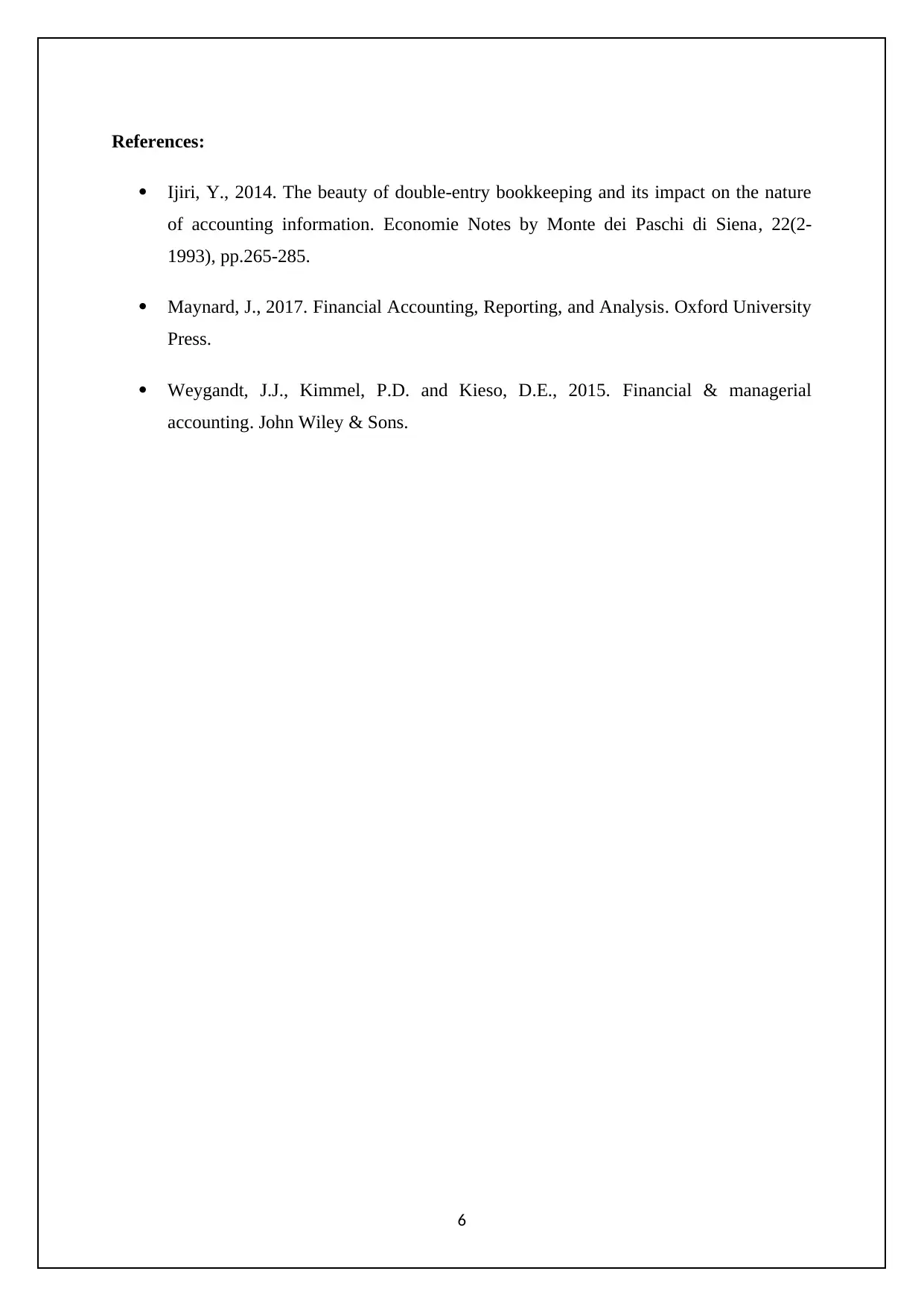
References:
Ijiri, Y., 2014. The beauty of double-entry bookkeeping and its impact on the nature
of accounting information. Economie Notes by Monte dei Paschi di Siena, 22(2-
1993), pp.265-285.
Maynard, J., 2017. Financial Accounting, Reporting, and Analysis. Oxford University
Press.
Weygandt, J.J., Kimmel, P.D. and Kieso, D.E., 2015. Financial & managerial
accounting. John Wiley & Sons.
6
Ijiri, Y., 2014. The beauty of double-entry bookkeeping and its impact on the nature
of accounting information. Economie Notes by Monte dei Paschi di Siena, 22(2-
1993), pp.265-285.
Maynard, J., 2017. Financial Accounting, Reporting, and Analysis. Oxford University
Press.
Weygandt, J.J., Kimmel, P.D. and Kieso, D.E., 2015. Financial & managerial
accounting. John Wiley & Sons.
6
⊘ This is a preview!⊘
Do you want full access?
Subscribe today to unlock all pages.

Trusted by 1+ million students worldwide
1 out of 6
Related Documents
Your All-in-One AI-Powered Toolkit for Academic Success.
+13062052269
info@desklib.com
Available 24*7 on WhatsApp / Email
![[object Object]](/_next/static/media/star-bottom.7253800d.svg)
Unlock your academic potential
Copyright © 2020–2025 A2Z Services. All Rights Reserved. Developed and managed by ZUCOL.





